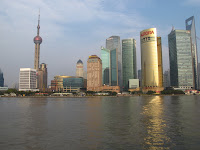Suzhou is a “small” city (11 million) not far from Shanghai and just over 30 minutes on the high speed train. It is variously known as the Garden City; the home of silk; the Bridge Museum; and the Venice of the East. This last descriptor is rather generous and is simply based upon the fact that the town was originally built on canals.
Canals imply bridges and the 354 old bridges give rise to the Bridge Museum nickname. As the production centre for the vast majority of Chinese silk the third nickname is self-evident and the last nickname is due to the 65 Chinese gardens that have been preserved in the city.
Our first stop was at the canal where we boarded our “slow boats to China” to be serenaded as we were transported along some fairly dismal canals to the Garden of the Couples Retreat. Chinese gardens have a rigidly formal informality about them and as mentioned before must incorporate rocks, water, plants and buildings and both the gardens visited today were not simply gardens but residences where the buildings scattered through the gardens were actually the functional rooms spread throughout the complex.


After a visit to a silk factory where we learnt how the 1500m silk thread was extracted from the cocoon and woven, along with the obligatory buying opportunity we had another Chinese meal and moved on to the second garden, the Garden of the Masters of the Fishing Nets. Fishing had absolutely nothing to do with the garden, it was simply that the retired official who built it wanted to adopt the “simple life” and the life of fishermen were synonymous with simplicity. The two gardens were wonderful examples of the art of Chinese gardens and very different to that which would be seen in Europe.


As we had a couple of hours before the train was due to whisk us back to Shanghai, the tour guide suggested we visit another part of the city where they have preserved some of the old buildings and with them, the traditional markets. Most of the old city has been flattened and replaced with high-rise apartments so the city fathers, in their wisdom have protected a couple of enclaves to keep a link with the past.
The market was very interesting with live fish, crabs, shrimps, chickens, pigeons, ducks, quail and various other species for sale along with vegetables, nuts, seeds, fruit and all manner of freshly cooked delights. The historic buildings were all converted to shops and it was very pleasant strolling along without the hard-sell of some of the other tourist areas.

Once the high-speed train had whisked us back to Shanghai we were on our own for dinner so we set off from our hotel in a different direction and within a couple of blocks had immersed ourselves back in “real China” with street markets, not unlike the one we had experienced in Suzhou. A bright, clean local restaurant attracted us so we stopped for dinner as there was English as well as Chinese on the menu. We could have selected “Same tasty dish”, “Serve hot” or “Double bacteria on hot iron dish” as well as dog and various other dubious options but we played it safe and enjoyed another very cheap and filling meal. Curiously, the most difficult item to acquire on our two solo dining expeditions has been rice.




























































